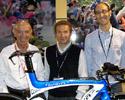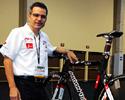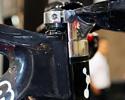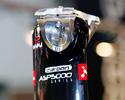
Recently on Cyclingnews.com |
Interbike Show
Las Vegas, Nevada, USA, September 24 - 28, 2007
Main Page Previous Part Next Part
Part 15: More bikes from Vegas
by Mark Zalewski and Tim Maloney
Argon 18 delivers E-114
|
|
|
|
|
The Interbike show is a natural platform for unveiling new products, concepts or dreams -- many of which are often still at the concept level and are not-yet-ready-for-prime-time. Argon 18 was in this category last year when it showed off its concept time trial frame, the E-114, which was more of a preview at the time than something that was ready to hit the road. This year, however, the company rolled out the actual production model along with a projected North American availability of January 2008.
According to Argon 18's Marc-André Perron, the overall theme of the E-114 is simplicity, and its defining feature is easily the fully integrated ‘ONEness’ front end. As BMC and Felt did with their respective time trial creations, the E-114’s carbon fork incorporates a pseudo-fairing that shields the head tube and smooths airflow around that area. The fork is then capped by a fully integrated aerobar setup that completely eliminates the need for a conventional stem, and the front brake caliper is shielded behind the fork crown.
"We eliminated the stem to give a nice, clean look with one solid piece,” said Perron. “It is wider than other brands, but it just came back from wind tunnel testing and it is more efficient than the Mercury and even the E-112.”
Some might be wary of a time trial or multisport bike that irrevocably integrates an item as personal and fit-dictated as aerobars, but Perron said that there is still a lot of adjustment potential built into the design. "There are two different angles for the aero bars and the bars are long enough that they can be cut to length. The seatpost is very simple in terms of adjustment. You either have a 76 degree angle or turn it around for a 78 degree, and then adjust the seat with just two bolts."
The frame tubes themselves are artfully sculpted, but not for looks as much as for aerodynamics. In particular, the rear wheel is well-shielded by a close-fitting seat tube and horizontal dropouts allow for an extra-tight fit. Argon 18 also sought to achieve simplicity in the E-114’s delivery as well, as the bike will apparently arrive at dealers mostly assembled with the integrated aerobars, seatpost and brake calipers already installed. "We wanted a compact unit that goes together easily. So basically you put [on] the seat, components, and wheels and you are ready to go. The rest is all integrated."
The package as pictured will retail for around US$3,800, and claimed frame weight for a medium size is 1425g plus another 595g for the integrated fork assembly. The latter figure may sound a bit unimpressive, but Argon 18 argues that weight is not usually the primary metric by which aerodynamic bikes should be measured. TThe weight is not an issue on a TT bike because it is mostly used on the flats," Perron said. "So we can use more [material] in tubing to make it stiff. And we don't believe in a short chain stay for two reasons: there less stability and also the chain line through there is affected."
As for why it took so long to get the E-114 from a show model to an actual production bike, Perron laughed and replied, "With our company, the ideas are not the problem; it is getting the manpower to implement them!" And for those that might not believe this is the actual production model, or that the aerodynamics are not what the company boasts, ponder this: triathlete Torbjorn Sindballe set the fastest bike split of the 2007 Hawaiian Ironman on what was just his first race on the E-114.
Colnago draws on its past while still looking ahead

|
Ernesto Colnago celebrated his 75th birthday this year and is the subject of new biography written by Italian cycling journalist Pier Agusto Stagi of TuttoBici. Colnago: La Bicicletta is a 315-page hardcover book that covers the life and times of the iconic framebuilder, including how he first began his own racing career and founded Colnago, as well as a history of Colnago’s successes in the pro peloton. The book was originally written in Italian but an English translation will be offered in the US by Colnago's new stateside distributor, Veltec Sports.
According to Veltec National Sales Manager Soren Krebs, "The book was a big hit; we are already out of Colnago: La Bicicletta because US Colnago dealers loved this book." Likewise, Ernesto Colnago himself told Cyclingnews, "I am very happy with the reaction to my new biography United States and our new collaboration with Veltec."
Changes to Colnago’s 2008 bicycle range will be mostly limited to colors and graphics (hardly a bad thing, considering it would be difficult to improve as it is). The one major exception is new 340g C75 carbon fork, which will replace the existing Star Carbon fork on the Extreme-C and Extreme Power framesets. Colnago will also offer the C-50 Extreme Power and the now-classic Master X-Light in a special retro paintjob to commemorate the company’s association with Italian cycling great Giuseppe Saronni.
Wilier Triestina makes US push

|
Wilier Triestina is a brand that celebrated its 100th anniversary in 2006, but it is nonetheless still relatively new to the US market. The line has been imported since 1999 through Velo Imports, but the Rossano Veneto, Italy-based Gasteldello family of Wilier Triestina has now created a joint venture with US distributors Angelo and Gianmarco Cilli to create Wilier Triestina USA. According to Angelo Cilli, the new arrangement “will provide better service and product availability for our US dealers."
From the looks of things, Wilier Triestina USA may not have to do all that much to convince dealers to carry its product, though. Lampre-Fondital’s Damiano Cunego just captured the 2007 Giro di Lombardia aboard the company’s Cento model, and just added the striking Izoard carbon fibre road model to its lineup for 2008.
One of the most interesting 2008 additions is the swoopy new Cento Crono carbon fiber time trial machine. The Cento Crono was apparently inspired by the lines of the Cento road model but was designed in collaboration with bicycle aerodynamics guru John Cobb to be the “fastest on the market.” Aero details include the ‘splitter’ on the dramatically dropped down tube and the raised top tube which supposedly smooth the airflow coming off the front wheel and back of the stem, respectively. The uniquely shaped seat tube also supposedly allows for better airflow control between the rider’s legs, and the two-position non-integrated aero seatpost allows for a wide range of adjustment for either time trial or triathlon disciplines without the need to cut anything.
Carrera uses building blocks for its new Phibra

|
Famous for the exploits of Marco Pantani and Claudio Chiapucci, Italian bicycle brand Carrera brings the intriguing new Phibra road frame to the market for 2008, and apparently it has already received a wram welcome, at least according to Carrera's Frank Boifava: "We had a great response to the Phibra at Eurobike and we've sold out the first production run."
The Phibra’s unique frame design incorporates Carrera’s ’2b double arc block technology’, which uses two arc-shaped high-modulus carbon fibre blocks to form the frame’s backbone. The upper ’block‘ starts at the head tube flows through the top tube to the rear monostay, and then finishes at the rear dropouts. The lower block similarly integrates the down tube, bottom bracket shell, and chain stays, and an integrated seat mast joins the two together. Critical areas on the 1.2kg frame are also reinforced with titanium mesh, and Carrera says the entire process is carried out in Italy. Frames will be available beginning this spring.
Photography
For a thumbnail gallery of these images, click here
Images by Jonathan Devich/epicimages.us
- Like a proud father, Argon 18's Gervais Rioux stands by his baby, the E-114.
- The E-114's defining feature is its fully integrated 'ONEness' front end.
- The flip-flop style of the integrated seatpost still allows for multiple positions.
- The integrated front end apparently offers greatly improved aerodynamics.
- The aerobars may be fully integrated but Argon 18 stresses that they still have a lot of available adjustment.
- The fork 'fairing' is somewhat wide , but supposedly is more effective at shielding the head tube than a narrower design.
- The sculpted tube shapes are more than pretty to look at ; wind tunnel testing apparently shows that their aerodynamic advantage is significant.
- An oversized carbon fiber bottom bracket area suggests efficient power transfer.
- Another view of the integrated headset with the fork.
- The sea tube area is designed for maximum aerodynamic efficiency.
- Even the brake calipers are integrated into the design to help cheat the wind.
- Ready to go, just add your favourite wheels, saddle and drivetrain!
Images by Tim Maloney/Cyclingnews.com
- Ernesto Colnago autographs his new biography for Bicycle Retailer's International Editor Doug McClellan.
- Ernesto Colnago (right) celebrates his new biography with Veltec Sports' Manfred Krikke (left) and Olympic silver medalist Nelson Vails (center).
- Veltec Sports' National Sales Manager Soren Krebs assists Colnago as he signs his new biography for US dealers.
Images by James Huang/Cyclingnews.com
- The Colnago Extreme-Power will be offered in this striking black-and-white paint job for 2008…
- …and includes some fantastic detailing.
- The Extreme-Power and Extreme-C models will also get the new Carbon 75 fork.
- Colnago will also offer the C-50 Extreme Power in this retro-inspired scheme to commemorate Colnago's association with Italian racing legend Giuseppe Saronni…
- …and for those who want something a little more classic , Colnago will also offer the look in its steel Master X-Light frameset.
- Colnago's CLX model promises to be a performance value for 2008.
- The C-50 Cross is just the ticket for the well-heeled 'cross racer.
- For those on a tighter budget , Colnago also offers this aluminum cyclocross model.
- Colnago displayed this excellent one-off complete track bike…
- …complete with leather-wrapped bars.
- Who needs brakes?
Images by Tim Maloney/Cyclingnews.com
- Wilier Triestina USA is a new joint venture between the Cilli and Gastaldello families. Pictured here are Angelo and Gianmarco Cilli of Wilier Triestina USA (left and right), and Enrico Gastaldello of Wilier Triestina (center).
- The swoopy Cento Crono is an all-new time trial/triathlon machine from Wilier Triestina.
- The dramatically shaped down tube includes a 'splitter' that supposedly helps smooth airflow coming off of the front wheel.
- Likewise, the raised top tube helps smooth the airflow coming off of the back of the stem.
- The new Wilier Triestina Cento Crono features Selle Italia's new triathlon saddle with its built-in bottle carrier.
- The Cento Crono was designed in collaboration with bicycle aero guru John Cobb.
- Damiano Cunego won his second Giro di Lombardia aboard a Wilier Triestina Cento.
- Carrera's Phibra with its "2b double arc block technology' was certainly one of the more unique bicycles presented at this year's Interbike show.
- The backbone of the Phibra consists of an upper and lower 'block', each of which runs from the head tube all the way back to the rear dropouts.
- The swoopy top tube of the new Carrera Phibra.
- The radically shaped seat tube of the Phibra includes a deep notch to fit the rear wheel.
- The massive bottom bracket zone and dramatically shaped down tube of the Carrera Phibra.



